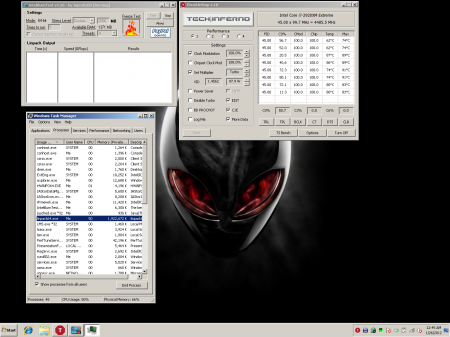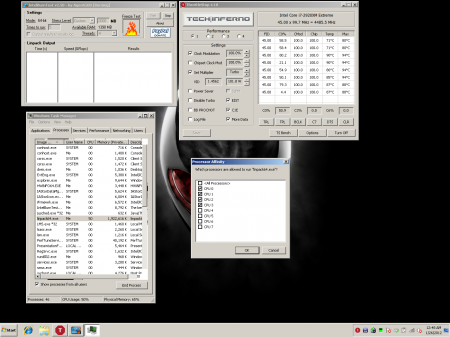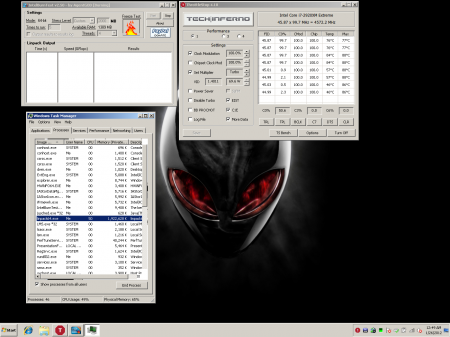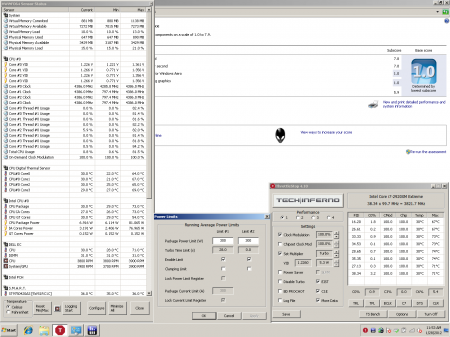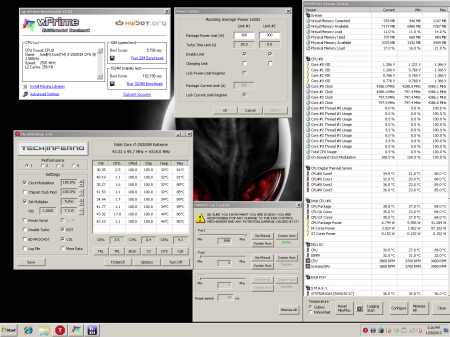Leaderboard
Popular Content
Showing content with the highest reputation on 03/31/12 in all areas
-
Direct link for beta drivers Win7 Source1 point
-
The challenge phoenix is that any bios besides A01 puts your (GPU speed) into a mobile mode and it severely downclocks it. What you can "try" to do is to see if the unlocked A08 allows you to manually clock the GPU on battery mode to something like 400/800/800.. Which is a more sensible clock speed on battery. I wish you the best of luck. the newer models of the m14x will not be able to utilize the older bios (example A01 or A03). Best wishes, StevenX1 point
-
1 point
-
I have some good contacts, should be nice and convenient for you also except you would have to import it into the US and I'm ten thousand miles away. Here is the best google can do for your "nice drive"1 point
-
*WORK IN PROGRESS MATERIAL POSTED IS READY BUT MORE TO COME* An Extreme Mobile Processor costs $1000 retail and at least $400 for a good engineering sample. There are plenty owners of the 2920/60XM chips and owners of M18x using unlocked bios provides optimal control over the unlocked processors power parameters including voltage (Turbo Flex VID), amperage (primary plane/TDC) and wattage (Short/Long Watt Limit / TDP). I had a system previous this one (i feel as though new system as motherboard, gpus and cpu are different) that i will refer to as 2920XM OEM sample 1. Later I will add test results from this first sample. The following is based on what i am going to refer to as 2920XM OEM sample 2 which by my test handles about 100mhz or more less and required a bit higher volts to get there. The following results are of sample 2 under the noted test conditions.Room temp was 70F using thermostat. The test system was Alienware M18x R1 with dual 6970M, i7 2920XM oem, oem ram 1600mhz modules @ 1333mhz, oem dual 750gb sata 2 HDs in Raid 0. Fan control was used and so was a notebook cooler and a small lift of the notebooks rear on rear of notebook cooler. These results represent a system given optimal airflow not enhanced cooling in anyway as in air intake is fresh room temp air and exhaust is blown away from system enough as to not recycle hot air back into system. This cooling cannot contribute to any sort of enhanced effect skewing results. The purpose is to reveal given no power limitations at all what overclocks are stable and what settings would one need to accomplish it. Given the method i chose the data should provide adequate understanding of how speed goes up and so does heat so in a dynamic chip as such a high speed overclock is only handled best in one to two cores and decreases as cores are added otherwise temperature becomes a limitation making such an overclock unviable... so stick to a given range and you shouldn't see temps higher in other apps since Intel Burn Test produces more heat and cpu load than most real world use apps. So use this chart as willed one can derive everyday overclocks or use reference for those of you who benchmark. I personally have and see more use not in benchmarking but real world use. To get similar results fan control is not required and very optional as system fan control will still start cooling when the cpu gets too hot, I just like to use defensive or pre-emptive cooling (preventative). For those of you overclocking its all about bang for buck yes? So pick one that best suits your system usage and get that buck out of your XM cpu. With these and the unlocked bios it takes the guessing game out of this or depending on a single overclock someone mentioned to cover all your needs... no its best to know an entire range. Brian K. you just acquired your 2920XM try gaming with the main overclock i not below using 0 flex... I am certain its useful. Before i made this i have a notebook of jumbled notes i made. This is my first attempt at this and to provide users with a useful guide. I will add more as I have time. I hope you all like it I tend to devalue my work. For about 3 months I gamed on 4.4ghz and used 44/44/44/44 at 0 flex using 97watts long limit and 2400 primary plane so 300watts the 97 watts keeps 0 flex voltage enough as under heavy load the 97 watts causes the cpu to drop in a more acceptable range but now I mapped the following I will use the last overclock at the bottom using 0 flex. The most coolest and highest 8thread capable overclock is the one using the least voltage. If one can use enhanced cooling like an air-conditioned climate controlled room perhaps one can use higher 8 thread loads but for average room temp the following should paint a great visualization of recommended ranges.The tests were done by stock baseclock that is 99.8 mhz in the bios which shows up as 99.7 in Windows. Thefollowing is presented and tested by using multipliers as the variable and for majority of tests other variables are the voltage and some watts are different but was needed to be higher as under the type of load in the program Intel Burn test i was using most cpus under stock settings are dropping to 3.2-3.4 or maybe 3.6-3.8ghz with a basic overclock. Using more amps is required not vice versa as one has to be higher the other doesnt need to be higher to yield better performance at same speed ranges and to prevent the mhz from dropping under load due to power restrictions... these cpus actively dynamically raise speed and volts many times a second and when a heavy work load like per say encoding, rendering, some gaming (the newer games are starting more two recomend quad core cpus) the mhz tend to drop even if temps are in check and thats because amps and watts arent high enough or voltage is too high. Given 97 amps and start raising watts shortly after 10-20 watts its ineffective at actually boosting the mhz max speed that it will maintain at those loads on 8 threads. Now do the opposite and you get a better performance yield... do both and your all set but I suggest raising AMPS / Primary Plane high and only ever changing watts so 2400 primary plane or 300 amps max has shown me it can push any ghz under any load other factors would be only limiting factors (temps). So 300 amps and 95-170 watts should be good to maintain any of the ranges below no matter how much your heating up. Note cpu heat raising requires more amps and watts for same load and speed interestingly enough... so like 97 amp 99 watt might maintain a speed under average temps but as temps raise from normal usage that amount alone can require more amps or watts if the watt and or amp limit retricts it anyway the speed drops... this is not throttling as that usually pertains to temps max limit imposed by maker. Another form of the cpu speed dropping not from thermal throttling is a pattern i noticed that despite all limiting factors not limiting things lol that if flex was too high it didnt matter how high i had amps or watts the voltage or flex being too high eventually imposes its own strange drop in mhz starting in 8thread working back to single thread the higher you go and huge amounts of heat if you attempt to near that new imposed max speed at that voltage so thats why the below chart shows where the thresholds are under such heavy workloads/ temps and even voltage ranges.There are other methods of overclock i have explored and can be used well too. using same high amps like 300 set a slightly higher frequency set than voltage will handle and use a little lower watts and under light loads you can use higher frequencies but as load raises youve saved it from bsod124 needing voltage because the cpu starts naturally dropping speed because of the watt limit you've set. example is setting 45X on multis and using lower flex than needed to keep cool and just enough watts to maintain 4.5ghz in a couple cores but when it comes down to it and voltage requirements start raising the watts keep it in check. So have at it decide what ranges you like as noted you dont need watts higher than 95-170 for the most part but amps should be way above 776primary plane or 97 amps which is the stock range. As i have time i have lower workload apps ill map out too which will take less time.... wprime and vantage are some post suggestions if you want me to try some for you. lesson benchers wprime 32m gets higher scores at higher mhz 8thread in both cases and only runs for a few seconds so heat is less an issue and higher scores yield from the higher mhz so do runs like that and if going for 1024m it about the highest 8thread it will do but temps will be an issue so you need to use as low a voltage possible again in both cases since unlike below we arent going for crash proofing but fastest coolest overclock to get a higher bench score... dont confuse below for that as its more for showing what can be used ofr a all day everyday overclock but has its uses for you guys benching and or trying different speeds and keep crashing not knowing whats the issue. not all cpus are alike but overall your cpus should handle the same ranges given the same settings... and if the app has lower load then it should no doubt run full speed and even cooler than i have posted. please not this is stock factory paste and i noted i have 2 cpu cores that are 10c hotter than other two from factory under and even 8thread load accross cores... so actually that helps make these results more protective of you guys because most wont see as high max temps on the cores as i did... 5 tests of Intel Burn Test (system is on stock OEM paste) 2000MB ram load at 5tests unless otherwise notedResults are interpreted as follows if a temp is noted per core that range was tested and passed and that was the resulting temp max via Throttle Stop with more data option (8 reads a second), if a - is noted the test was not performed possibly uneeded, if BSOD124 is noted that meant the test was performed and crashed due to requiring more voltage and finally if Thermal Shutdown is written the system failed to maintain thermal stability and thermal protection kicked in turning off the system. each test of 5 took any-wheres from 6 minutes to 15min depending on threads used[ATTACH=CONFIG]3394[/ATTACH] 1 Before a Dual Core run showing IBT and TS configured [ATTACH=CONFIG]3395[/ATTACH] 2 During the beggining of a Dual Core run [ATTACH=CONFIG]3396[/ATTACH] 3 During the beggining of a Dual Core run SHOWING AFFINITY [ATTACH=CONFIG]3397[/ATTACH] 4 During the beggining of a Dual Core run SHOWING AFFINITY SET TO DUAL CORE [ATTACH=CONFIG]3398[/ATTACH] 5 During the beggining of a Dual Core run SHOWING AFFINITY SET TO DUAL CORE AND IT RUNNING temps and stats on 44/44/43/43 300 amp/300watt[ATTACH=CONFIG]3399[/ATTACH] 44 44 43 43 tdp 300 tdc 300 flex 0 wei cpu 7.8 [ATTACH=CONFIG]3400[/ATTACH] 44 44 43 43 tdp 300 tdc 300 flex 0 wei cpu 7.8 20tests IBT 2 4 6 8 threads [ATTACH=CONFIG]3401[/ATTACH] 44 44 43 43 tdp 300 tdc 300 flex 0 wei cpu 7.8 wprime 1024m 23m [ATTACH=CONFIG]3402[/ATTACH] 44 44 43 43 tdp 300 tdc 300 flex 0 wei cpu 7.8 super pi 32m [ATTACH=CONFIG]3403[/ATTACH] 44 44 43 43 tdp 300 tdc 300 flex 0 wei cpu 7.8 super pi all scores[/CENTER] TDP/Watts TDC/Amp/Primary Plane Voltage/Flex Speed Range Tested Ghz Multipliers 1 Core 2 thread Temps 2 Core 4 Thread Degrees Celcius 3 core 6 Thread 4 Core 8 Thread 99 2400 Primary Plane / 300 Amp 25 4.5 45/45/45/45 68 100 - - 105 300 25 4.0 40/40/40/40 - - 99 - 99 300 25 3.7 37/37/37/37 - - - 99 99 300 25 4.6 46/45/40/37 69 - - - 99 300 25 4.6 46/45/45/45 73 - - - 99 300 25 4.7 47/45/45/45 71 - - - 99 300 25 4.8 48/45/45/45 BSOD124 - - - 99 300 27 4.8 48/45/45/45 71 - - - 105 300 28 4.8 48/45/45/45 BSOD124 - - - 105 300 29 4.8 48/45/45/45 BSOD124 72c - - - 110 300 30 4.8 48/45/45/45 BSOD124 73C - - - 110 300 31 4.8 48/45/45/45 76 - - - 300 300 31 4.8 48/45/45/45 BSOD124 - - - 300 300 99 4.8 48/45/45/45 91 - - - 300 300 99 4.9 49/45/45/45 92 - - - 300 300 99 5.0 50/45/45/45 BSOD124 (CPU FREQUENCY CEILING) - - - 300 300 33 4.9 49/45/45/45 BSOD124 - - - 300 300 44 4.9 49/45/45/45 81 - - - 300 300 44 4.9-3.7 49/45/40/37 81 86 95 100 300 300 31 4.8 48/45/45/45 BSOD124 - - - 300 300 33 4.8 48/45/45/45 75 - - - 300 300 32 4.8 48/45/45/45 BSOD124 75C - - - 300 300 33 4.5 48/45/45/45 - 89 100 - 300 300 33 4.0 48/45/40/37 - - 92 - 300 300 33 3.7 48/45/40/37 - - - 97 300 300 33 4.6 48/46/41/37 - 86 97 - 300 300 33 4.7 48/47/41/37 - 87 - - 300 300 33 4.7 48/47/45/45 - 91 - - 300 300 33 4.8 48/48/45/45 - BSOD124 - - 300 300 34 4.8 48/48/45/45 - BSOD124 - - 300 300 35 4.8 48/48/45/45 - BSOD124 - - 300 300 36 4.8 48/48/45/45 - 95 - - 300 300 36 3.7-4.1 48/48/41/37 - - 98 95 300 300 33 3.8-4.2 48/47/42/38 - - 98 97 300 300 36 3.8 48/48/41/38 - - - 98 300 300 33 3.9-4.8 48/47/43/39 BSOD124 86 100 99 300 300 44 3.7-4.9 49/48/40/37 80 91 91 96 300 300 34 3.7-4.8 48/47/43/39 BSOD124 - - - 300 300 35 4.8 48/47/43/39 79 88 100 THERMAL SHUTDOWN 300 300 35 3.8 48/47/43/38 - - - 98 300 300 20 4.7 47/45/45/45 BSOD124 - - - 300 300 44 4.9 49/48/41/38 84 93 97 99 300 300 44 4.9 49/49/41/38 83 BSOD124 - - 300 300 50 4.9 49/49/41/38 - BSOD124 - - 300 300 24 4.7 47/45/45/45 70 - - - 300 300 25 4.7 47/47/45/45 - BSOD124 - - 300 300 27 4.7 47/47/45/45 74 85 - - 300 300 27 4.7 47/47/45/40 - - - THERMAL SHUTDOWN 300 300 27 4.7 47/47/45/39 - - 100 99 300 300 24 4.6 47/46/45/45 BSOD124 82 - - 300 300 25 4.7 47/46/45/45 70 85 - - 300 300 25 4.5-4.0 47/46/45/40 - - THERMAL SHUTDOWN THERMAL SHUTDOWN 300 300 24 4.5-4.0 47/45/45/40 - - 100 THERMAL SHUTDOWN 300 300 25 4.4-3.9 47/46/44/39 - - 100 99 300 300 24 4.5-3.9 47/45/45/39 - - - - 300 300 20 4.6 46/46/45/45 - 87 - - 300 300 19 4.6-4.5 46/46/45/45 71 87 THERMAL SHUTDOWN THERMAL SHUTDOWN 300 300 18 4.6 46/46/45/45 - 84 - - 300 300 16 4.6 46/46/45/40 - 84 - - 300 300 14 4.6 46/46/45/40 - BSOD124 - - 300 300 15 4.6 46/46/45/40 - BSOD124 - - 300 300 16 4.0 46/46/45/40 - - - THERMAL SHUTDOWN 300 300 16 4.6-3.9 46/46/45/39 - BSOD124 100 99 300 300 17 4.6-3.9 46/46/45/39 BSOD124 84 100 99 300 300 14 4.6 46/45/45/40 BSOD124 - - - 300 300 18 4.6-3.9 46/46/45/39 70 84 100 99 300 300 15 4.6 46/45/45/40 BSOD124 - - - 300 300 16 4.6 46/45/45/40 BSOD124 - - - 300 300 17 4.6 46/45/45/40 BSOD124 - - - 300 300 14 4.5-4.0 45/45/45/40 67 82 100 THERMAL SHUTDOWN 300 300 12 4.5-4.0 45/45/45/40 63 76 96 100 300 300 10 4.5-4.0 45/45/45/40 63 75 96 97 300 300 9 4.5-4.0 45/45/45/40 - BSOD124 94 96 300 300 10 4.5-4.1 45/45/45/41 - - 95 99 300 300 O 4.4 44/44/44/42 BSOD124 - - - 300 300 1 4.4 44/44/44/42 BSOD124 - - - 300 300 2 4.4-4.2 44/44/44/42 BSOD124 - - - 300 300 4 4.4-4.2 44/44/44/42 60 73 93 99 300 300 O 4.3 43/43/43/43 59 70 89 99 300 300 O 4.4-4.3 44/43/43/43 59 76 88 98 300 300 O 4.5-4.3 45/43/43/43 BSOD124 - - - 300 300 O 4.4-4.3 44/44/43/43 59 70 89 99 300 *THIS TEST UNLIKE ALL OF ABOVE WAS DONE 20 TESTS FOR EACH CORE INSTEAD OF 5 LIKE THE ABOVE TESTS PER CORE. 300 *NOTE THE TEMPS ARE BARELY HIGHER THAN THE 5 TESTS UNDER IBT MOST CPUS MUST DROP THEIR SPEED ONLY A TEST OR TWO IN CONFIGURED WITH 300 WATT MAX AND AMP IT WONT (THESE ARE NOT ACTUALLY DRAWING ANYTHING NEAR THAT THE VALUES ARENT TAKEN LITERAL BUT USED IN A FORMULA MADE BY iNTEL) O 4.4-4.3 44/44/43/43 60 73 91 991 point








